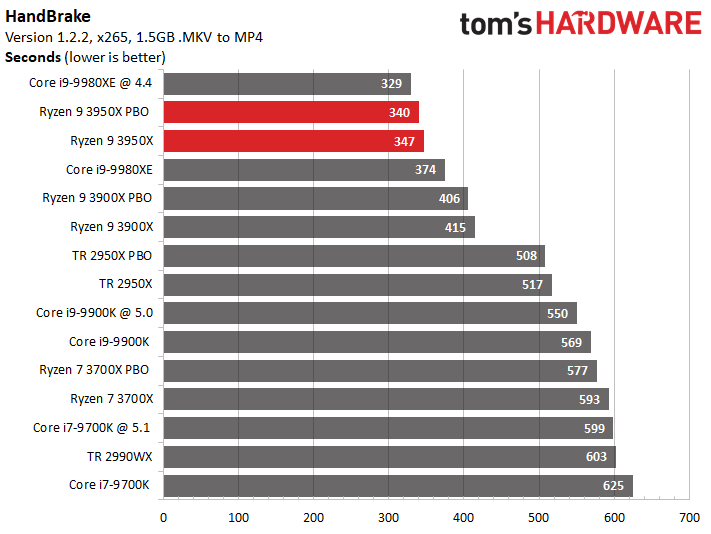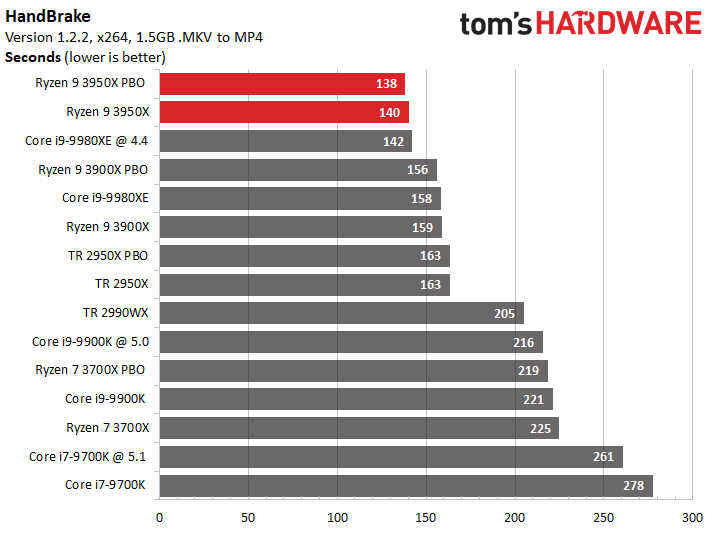Why you can trust Tom's Hardware
Ryzen 9 3950X Boost Frequency
In light of the controversy surrounding Ryzen 3000's ability to reach its rated boost clocks, we turned the same amount of attention to the Ryzen 9 3950X as we have in our series of other Ryzen 3000 boost clock tests.
AMD recommends a 280mm AIO watercooler as the minimum bar for entry for the Ryzen 9 3950X, and advises that beefier coolers can unlock more performance. For stock testing, we used the same Corsair H115i 280mm watercoolers that we use in the lab for testing chips that don't come with a bundled cooler. We also used a beefy custom watercooling loop with two 360mm radiators for overclocking testing.
You'll need to install the 1.0.0.4B BIOS (or newer) in tandem with AMD's chipset drivers to enable the UEFI CPPC2 interface, which allows the operating system to prioritize scheduling threads into the fastest cores of the processor first. The chipset drivers also automatically install the required AMD-designed power plans (we recommend AMD's Ryzen High Performance Power Profile for enthusiasts). You'll also need the Windows May 2019 Update (or later) to enable the topology-aware scheduling implementation. Also, be aware that silicon quality, your motherboard, and firmware all play a role in the efficacy of AMD's unique boosting implementation, so your results may vary.



With those prerequisites in place, we turned to our now-standard test for measuring boost clocks. We begin by recording the frequencies of each core during a series of commonly-used tests that should expose the peak frequencies. The first two tests are LAME and Cinebench in single-core test mode. These programs only execute on one core of the processor, which typically allows the chip to reach its peak boost frequency within its power, current, and thermal envelope. We also used tests with intermittent "bursty" workloads: PCMark 10, Geekbench, and VRMark run in rapid succession after the first two tests.
With 16 cores hammering away, the per-core frequency recordings create almost-unintelligible charts, so the album above only includes the maximum and minimum frequencies recorded during each 1-second measurement interval (100ms sampling). That means these measurements could come from any one core, but it makes the charts easier to digest. We've also plotted chip temperature on the right axis (the dark red line).
We reached 4.7 GHz frequently during our tests, though you'll notice these boost frequencies are exceedingly short in duration, while Intel's processors tend to reach their boost clock and stay there for longer periods of time (contingent upon BIOS settings).
We frequently reached 4.7 GHz with the Corsair H115i cooler, and even recorded a few bursts of 4.75 GHz. Better cooling yields much better results: At stock settings, we reached 4.75GHz much more frequently when we topped the chip with an EKWB waterblock connected to our custom loop, and overall boost activity was much more frequent. Finally, we enabled AMD's auto-overclocking PBO feature to measure peak clocks, and again reached 4.75 GHz regularly with the custom loop.
Get Tom's Hardware's best news and in-depth reviews, straight to your inbox.
We also examined the output from our logging software and noticed that the boost activity occurred much more frequently in active cores. That's an improvement over what we've seen with past firmwares that incorrectly boosted inactive cores. This indicates that the UEFI CPP2 interface is working correctly to enable Windows 10's Ryzen topology-aware thread scheduling.
Temperatures peaked at 75C with the Corsair H115i's fans cranking away at full speed, but these workloads primarily consist of lightly-threaded activity with short bursts of multi-threaded activity.
Ryzen 9 3950X Overclocking
AMD's Ryzen 3000 processors have drastically improved single-threaded performance, but you'll lose that benefit if you manually overclock. That's simply because the chips can't be manually overclocked on all cores to reach the same frequency as the single-core boost frequency. In fact, we often find the all-core overclock ceiling to be 200 to 300 MHz lower than the rated boost speeds, which is likely due to AMD’s new binning strategy that finds the Ryzen 3000 chips with a mix of both faster and slower cores.
As we've seen with other Ryzen processors, we couldn't maintain an all-core overclock beyond 4.3 GHz, which is well short of the 3950X's 4.7 GHz boost clock. As such, an all-core overclock has the predictable result of boosting performance in some heavily-threaded workloads, but the reduction in performance in lightly-threaded applications isn't worth the trade-off.
We had relatively little time during the NDA window to manually overclock the 3950X, so it's possible further tuning could expose larger gains. The overclocked 3950X's thermal output easily overwhelmed our 280mm AIO, so plan for a beefy watercooling solution if you plan on overclocking.
We turned to AMD's auto-overclocking Precision Boost Overdrive feature for our battery of tests. This auto-overclocking algorithm preserves the benefits of the single core boost, as seen in our boost testing above, while speeding up threaded workloads. We did pair our PBO-enabled configuration with our custom watercooling loop, enabling the utmost performance possible with our available cooling solutions. However, PBO performance will vary based upon your cooling solution, motherboard, and firmware.
Ryzen 9 3950X Power Consumption
It's important to remember that TDP isn't a one-to-one measure of power consumption. In the simplest terms, this rating quantifies the required performance of the CPU cooler based upon the chips' thermal dissipation – not power consumption. That means we won't see the Ryzen 9 3950X operate at 105W of power consumption.
Power consumption measurements are always a bit tricky. But as long as your 12V supply (EPS) readings, motherboard power supply sensor values, and voltage transformer losses plausibly coincide, everything is fine. Therefore, we're using pure package power to avoid possible influences from our motherboard. Results from the PWM controller are very reliable if you take them as averages over a few minutes











We measured great power consumption from the Ryzen 9 3950X during our synthetic AIDA64 stress tests with non-AVX and AVX workloads, however, the synthetic power tests could be a bit misleading. Here we see that the stock 3950X consumes the same amount of power as the Ryzen 9 3900X, which has four fewer active cores, in both tests. The overclocked 3950X also consumes less power than the overclocked 3900X, which doesn't make sense given its higher allotment of cores. While comparing notes with Ian Cutress at AnandTech, he noted that the 3950X draws less power when more cores are active than it does when lightly loaded. For instance, he measured peak power with 10 cores loaded, but a significant drop in overall power consumption as more cores came under load.
This is obviously a clever implementation by AMD to mitigate the thermal and power density issues associated with cramming 16 cores into such a small package, but it does mean that we'll have to chart out per-core power draw for a better view of synthetic power load. We'll update the article as necessary.
This type of power distribution is best measured by using a sustained workload with quantifiable performance metrics, such as our standard y-cruncher and Handbrake x264 and x265 tests, the latter of which has a heavier distribution of densely-packed AVX instructions. The y-cruncher tests show that while the 3900X draws more power during the test, it actually provides slightly better performance.
AVX instructions need copious data throughput, and the extra cores on the 3950X might incur a slight penalty from contention on the Infinity Fabric. The 3950X's 16 cores also have access to roughly the same aggregate memory bandwidth as the 12-core Ryzen 9 3900X, which means it has reduced memory throughput per core. That can manifest as reduced scaling in some workloads. You'll notice the overclocked Threadripper 2950X isn't present in the y-cruncher chart, but that's because the system repeatedly crashed during this single benchmark, indicating that either the motherboard firmware or AMD's PBO algorithms could use some additional work.
We see much the same trends emerge with our Handbrake tests, with the Ryzen 9 3900X consuming a similar amount, or slightly more, power than the Ryzen 9 3950X. However, these workloads tend to spread across the cores but not fully saturate them, which likely allows the 3950X to benefit from operating lower on the voltage/frequency curve, much like we observed with the Ryzen 9 3900, but still benefit from the parallelism of having more active cores. That equates to lower power consumption than the 3900X during the task even though the 3950X handily wins both benchmarks. Overall, the 3950X is incredibly power efficient.
| AMD Socket AM4 (X570) | AMD Ryzen 9 3950X, 3900X, Ryzen 7 3700X |
| MSI MEG X570 Godlike | |
| 2x 8GB G.Skill Flare DDR4-3200 | |
| Row 3 - Cell 0 | 2x 8GB G.Skill FlareX DDR4-3200 - Stock: DDR4-3200, OC: DDR4-3600 |
| Intel LGA 1151 (Z390) | Intel Core i9-9900K, i7-9900K |
| MSI MEG Z390 Godlike | |
| 2x 8GB G.Skill FlareX DDR4-3200 - Stock: DDR4-2666, OC: DDR4-3600 | |
| All Systems | Nvidia GeForce RTX 2080 Ti |
| 2TB Intel DC4510 SSD | |
| EVGA Supernova 1600 T2, 1600W | |
| Windows 10 Pro (1903 - All Updates) | |
| Cooling | Corsair H115i |
MORE: Best CPUs
MORE: Intel & AMD Processor Hierarchy
MORE: All CPUs Content
Current page: Boost Speeds, Power Consumption, Thermal Testing
Prev Page A Class of Its Own Next Page Ryzen 9 3950X Gaming
Paul Alcorn is the Editor-in-Chief for Tom's Hardware US. He also writes news and reviews on CPUs, storage, and enterprise hardware.